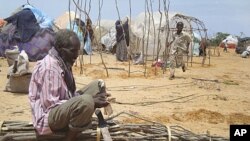The U.N. refugee agency reports fewer Somali refugees are crossing into Kenya due to continuing conflict and bad weather in Somalia. The agency says some Somalis are being prevented from fleeing by the Islamist militant group al-Shabab.
The U.N. refugee agency reports heavy rains are making many roads in Somalia impassable. This, it says, is slowing the previous flow of Somalis in search of asylum and humanitarian assistance.
But, the bad weather is only part of the story. The UNHCR says fear of getting caught in the ongoing conflict between the government and al-Shabab militants, as well as military activity along the Somali-Kenyan border, also is slowing the refugee exodus.
Despite these impediments, U.N. refugee spokesman Adrian Edwards says Somali refugees continue to arrive in the town of Dhobley, which is just 18 kilometers from the Kenyan border. He says many appear deeply distressed.
“They tell our staff they fled rumored impending military clashes in the area, and threats of forced return by al-Shabab to their places of origin," said Edwards. "Last weekend, six trucks containing almost 180 displaced people from Afgooye district, the majority from the K50 IDP camp, arrived in Dhobley after traveling for 27 days on flooded roads. They said that they had been instructed by al-Shabab to return to their farms but opted instead to travel to Dhobley in search of humanitarian help.”
In October, the Kenyan government sent hundreds of troops into southern Somalia with the goal of subduing al-Shabab. This followed a spate of kidnappings in Kenya that the government blamed on the militant group.
The Kenyan military presence has increased fighting in the region and worsened the situation around Dhobley, which is the main transit point for Somalis en route to Kenya. The Kenyan government says it plans to keep its forces in Somalia until the threat of the insurgents has been reduced.
Edwards says it is difficult to assess what impact the Kenyan military presence in Somalia is having on the humanitarian situation.
“It is hard to comment on the rumors themselves," he said. "But, clearly displaced people or civilians in general are in an environment where there is a significant fear of conflict whoever the parties to the conflict are…. Nonetheless, you know as well as I do that these people are in an area where there are at least two, possibly more parties to the conflict.”
The United Nations reports more than 12 million people have been affected by the worst drought to hit the Horn of Africa in 60 years, though conditions have begun to improve.
Hundreds of thousands of Somalis fleeing famine and conflict have gone to neighboring Kenya, Ethiopia and Djibouti. The numbers in Kenya’s Dadaab refugee complex keep going up. Dadaab originally was designed to hold 90,000 people. It now is home to nearly half a million.
Fewer Somalis Fleeing To Kenya
- By Lisa Schlein













